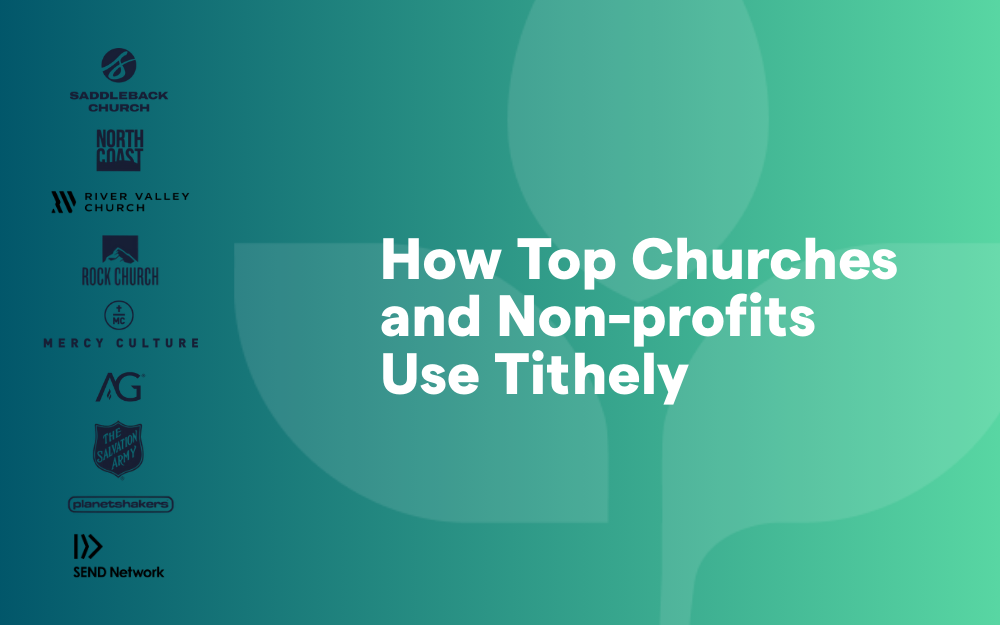Top 5 Giving Metrics Every Church Should Track

Giving and data are two of the least exciting subjects in the church.
However, they’re also two of the most important.
Your church cannot continue to operate if people don’t give. And you cannot tell if enough people are giving without measuring the right data.
Understanding both church giving and data analytics are key to healthy church growth. While there’s a great deal to learn in both areas, here are some of the top giving metrics to pay attention to.
#1. Percentage of Members Giving
How many of your church attenders give to your church on a regular basis? This is a tough question to answer without some research, but it’s good information to keep handy.
Measuring tithing among members can be tough, especially since you won’t have household income information for your entire church. Start by finding out how many unique givers you have each month. Then compare that to your church membership.
Studies show that only about 10–25% of most church members tithe. How does your church compare to that? Monitor the percentage of givers in your church as a gauge of financial health among your congregation.
#2. Giving Growth
Is your church giving growing at the same rate as your church membership? Just as your church should always be growing in members, it should also be growing in the number of regular givers.
These two metrics (attendance and givers) should roughly mirror one another. As your attendance increases, so should your number of donations each month. This shows a direct correlation between your church size and those contributing to the church financially.
If your church is growing in attendance, but there’s a stagnation in giving, you’ll need to do some investigation. Why aren’t any new members giving to the church? Do they understand the significance of tithing? Or is there a larger issue with access to giving opportunities?
#3. Average Gift Size
How much are people giving each month? If most members are tithing based on their income, this number should be steady and predictable. But one-time gifts can vary on the individual and timing.
Start tracking the average size of monthly gifts and how many gifts fall into certain size brackets. Does your average gift stay consistent from month to month? Or is it variable? Do most members give in smaller numbers regularly? Or make larger, one-time gifts?
Measuring these figures can help you to start identifying trends and predict patterns. That way, you’re not surprised if giving is suddenly down over the summer or peaks around Christmastime.
#4. Giving Trends
What time of the month do most of your tithers give? Which day of the week do your members prefer? Is there are time of the year when giving is especially high or low? Tracking giving over the course of every week, month and year can help to identify trends that answers each of these questions.
For instance, did you know that 10% of giving happens on the first day of the month and the last two days combined? Did you know that 33% of church giving happens on Sunday? That’s the biggest single day, but that still leaves two-thirds of giving that happens during the rest of the week.
This is important because this shows patterns for when you can expect church members to give. It also highlights areas when you need giving to be accessible — otherwise you risk discouraging a member from giving and having a poor customer experience.
#5. Giving Source Breakdown
How do your church members prefer to give? Do they prefer an offering bucket, a kiosk or mobile giving? By measuring how many donations comes through each of these sources, you can figure out how and why your church members like to give best.
By determining which sources most people prefer to use, you can focus on making those sources easier to use and more accessible. If no one is bothering to use the giving kiosk, why have one? If half of your giving comes through mobile gifts, perhaps there’s a way to enhance that option.
Read More
- The State of the Plate 2016 Giving Report
- 10 Surprising Church Giving Facts
- 5 Important Stats for Churches to Understand
- The Truth About Christians Tithing In The U.S.
- What Would Happen if the Church Tithed?
What giving metrics are you already tracking? How can this information help you to make giving easier at your church?
Sign Up for Product Updates
Giving and data are two of the least exciting subjects in the church.
However, they’re also two of the most important.
Your church cannot continue to operate if people don’t give. And you cannot tell if enough people are giving without measuring the right data.
Understanding both church giving and data analytics are key to healthy church growth. While there’s a great deal to learn in both areas, here are some of the top giving metrics to pay attention to.
#1. Percentage of Members Giving
How many of your church attenders give to your church on a regular basis? This is a tough question to answer without some research, but it’s good information to keep handy.
Measuring tithing among members can be tough, especially since you won’t have household income information for your entire church. Start by finding out how many unique givers you have each month. Then compare that to your church membership.
Studies show that only about 10–25% of most church members tithe. How does your church compare to that? Monitor the percentage of givers in your church as a gauge of financial health among your congregation.
#2. Giving Growth
Is your church giving growing at the same rate as your church membership? Just as your church should always be growing in members, it should also be growing in the number of regular givers.
These two metrics (attendance and givers) should roughly mirror one another. As your attendance increases, so should your number of donations each month. This shows a direct correlation between your church size and those contributing to the church financially.
If your church is growing in attendance, but there’s a stagnation in giving, you’ll need to do some investigation. Why aren’t any new members giving to the church? Do they understand the significance of tithing? Or is there a larger issue with access to giving opportunities?
#3. Average Gift Size
How much are people giving each month? If most members are tithing based on their income, this number should be steady and predictable. But one-time gifts can vary on the individual and timing.
Start tracking the average size of monthly gifts and how many gifts fall into certain size brackets. Does your average gift stay consistent from month to month? Or is it variable? Do most members give in smaller numbers regularly? Or make larger, one-time gifts?
Measuring these figures can help you to start identifying trends and predict patterns. That way, you’re not surprised if giving is suddenly down over the summer or peaks around Christmastime.
#4. Giving Trends
What time of the month do most of your tithers give? Which day of the week do your members prefer? Is there are time of the year when giving is especially high or low? Tracking giving over the course of every week, month and year can help to identify trends that answers each of these questions.
For instance, did you know that 10% of giving happens on the first day of the month and the last two days combined? Did you know that 33% of church giving happens on Sunday? That’s the biggest single day, but that still leaves two-thirds of giving that happens during the rest of the week.
This is important because this shows patterns for when you can expect church members to give. It also highlights areas when you need giving to be accessible — otherwise you risk discouraging a member from giving and having a poor customer experience.
#5. Giving Source Breakdown
How do your church members prefer to give? Do they prefer an offering bucket, a kiosk or mobile giving? By measuring how many donations comes through each of these sources, you can figure out how and why your church members like to give best.
By determining which sources most people prefer to use, you can focus on making those sources easier to use and more accessible. If no one is bothering to use the giving kiosk, why have one? If half of your giving comes through mobile gifts, perhaps there’s a way to enhance that option.
Read More
- The State of the Plate 2016 Giving Report
- 10 Surprising Church Giving Facts
- 5 Important Stats for Churches to Understand
- The Truth About Christians Tithing In The U.S.
- What Would Happen if the Church Tithed?
What giving metrics are you already tracking? How can this information help you to make giving easier at your church?
podcast transcript
Giving and data are two of the least exciting subjects in the church.
However, they’re also two of the most important.
Your church cannot continue to operate if people don’t give. And you cannot tell if enough people are giving without measuring the right data.
Understanding both church giving and data analytics are key to healthy church growth. While there’s a great deal to learn in both areas, here are some of the top giving metrics to pay attention to.
#1. Percentage of Members Giving
How many of your church attenders give to your church on a regular basis? This is a tough question to answer without some research, but it’s good information to keep handy.
Measuring tithing among members can be tough, especially since you won’t have household income information for your entire church. Start by finding out how many unique givers you have each month. Then compare that to your church membership.
Studies show that only about 10–25% of most church members tithe. How does your church compare to that? Monitor the percentage of givers in your church as a gauge of financial health among your congregation.
#2. Giving Growth
Is your church giving growing at the same rate as your church membership? Just as your church should always be growing in members, it should also be growing in the number of regular givers.
These two metrics (attendance and givers) should roughly mirror one another. As your attendance increases, so should your number of donations each month. This shows a direct correlation between your church size and those contributing to the church financially.
If your church is growing in attendance, but there’s a stagnation in giving, you’ll need to do some investigation. Why aren’t any new members giving to the church? Do they understand the significance of tithing? Or is there a larger issue with access to giving opportunities?
#3. Average Gift Size
How much are people giving each month? If most members are tithing based on their income, this number should be steady and predictable. But one-time gifts can vary on the individual and timing.
Start tracking the average size of monthly gifts and how many gifts fall into certain size brackets. Does your average gift stay consistent from month to month? Or is it variable? Do most members give in smaller numbers regularly? Or make larger, one-time gifts?
Measuring these figures can help you to start identifying trends and predict patterns. That way, you’re not surprised if giving is suddenly down over the summer or peaks around Christmastime.
#4. Giving Trends
What time of the month do most of your tithers give? Which day of the week do your members prefer? Is there are time of the year when giving is especially high or low? Tracking giving over the course of every week, month and year can help to identify trends that answers each of these questions.
For instance, did you know that 10% of giving happens on the first day of the month and the last two days combined? Did you know that 33% of church giving happens on Sunday? That’s the biggest single day, but that still leaves two-thirds of giving that happens during the rest of the week.
This is important because this shows patterns for when you can expect church members to give. It also highlights areas when you need giving to be accessible — otherwise you risk discouraging a member from giving and having a poor customer experience.
#5. Giving Source Breakdown
How do your church members prefer to give? Do they prefer an offering bucket, a kiosk or mobile giving? By measuring how many donations comes through each of these sources, you can figure out how and why your church members like to give best.
By determining which sources most people prefer to use, you can focus on making those sources easier to use and more accessible. If no one is bothering to use the giving kiosk, why have one? If half of your giving comes through mobile gifts, perhaps there’s a way to enhance that option.
Read More
- The State of the Plate 2016 Giving Report
- 10 Surprising Church Giving Facts
- 5 Important Stats for Churches to Understand
- The Truth About Christians Tithing In The U.S.
- What Would Happen if the Church Tithed?
What giving metrics are you already tracking? How can this information help you to make giving easier at your church?
VIDEO transcript
Giving and data are two of the least exciting subjects in the church.
However, they’re also two of the most important.
Your church cannot continue to operate if people don’t give. And you cannot tell if enough people are giving without measuring the right data.
Understanding both church giving and data analytics are key to healthy church growth. While there’s a great deal to learn in both areas, here are some of the top giving metrics to pay attention to.
#1. Percentage of Members Giving
How many of your church attenders give to your church on a regular basis? This is a tough question to answer without some research, but it’s good information to keep handy.
Measuring tithing among members can be tough, especially since you won’t have household income information for your entire church. Start by finding out how many unique givers you have each month. Then compare that to your church membership.
Studies show that only about 10–25% of most church members tithe. How does your church compare to that? Monitor the percentage of givers in your church as a gauge of financial health among your congregation.
#2. Giving Growth
Is your church giving growing at the same rate as your church membership? Just as your church should always be growing in members, it should also be growing in the number of regular givers.
These two metrics (attendance and givers) should roughly mirror one another. As your attendance increases, so should your number of donations each month. This shows a direct correlation between your church size and those contributing to the church financially.
If your church is growing in attendance, but there’s a stagnation in giving, you’ll need to do some investigation. Why aren’t any new members giving to the church? Do they understand the significance of tithing? Or is there a larger issue with access to giving opportunities?
#3. Average Gift Size
How much are people giving each month? If most members are tithing based on their income, this number should be steady and predictable. But one-time gifts can vary on the individual and timing.
Start tracking the average size of monthly gifts and how many gifts fall into certain size brackets. Does your average gift stay consistent from month to month? Or is it variable? Do most members give in smaller numbers regularly? Or make larger, one-time gifts?
Measuring these figures can help you to start identifying trends and predict patterns. That way, you’re not surprised if giving is suddenly down over the summer or peaks around Christmastime.
#4. Giving Trends
What time of the month do most of your tithers give? Which day of the week do your members prefer? Is there are time of the year when giving is especially high or low? Tracking giving over the course of every week, month and year can help to identify trends that answers each of these questions.
For instance, did you know that 10% of giving happens on the first day of the month and the last two days combined? Did you know that 33% of church giving happens on Sunday? That’s the biggest single day, but that still leaves two-thirds of giving that happens during the rest of the week.
This is important because this shows patterns for when you can expect church members to give. It also highlights areas when you need giving to be accessible — otherwise you risk discouraging a member from giving and having a poor customer experience.
#5. Giving Source Breakdown
How do your church members prefer to give? Do they prefer an offering bucket, a kiosk or mobile giving? By measuring how many donations comes through each of these sources, you can figure out how and why your church members like to give best.
By determining which sources most people prefer to use, you can focus on making those sources easier to use and more accessible. If no one is bothering to use the giving kiosk, why have one? If half of your giving comes through mobile gifts, perhaps there’s a way to enhance that option.
Read More
- The State of the Plate 2016 Giving Report
- 10 Surprising Church Giving Facts
- 5 Important Stats for Churches to Understand
- The Truth About Christians Tithing In The U.S.
- What Would Happen if the Church Tithed?



























